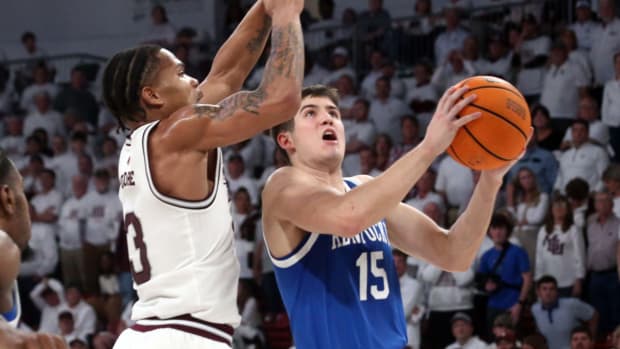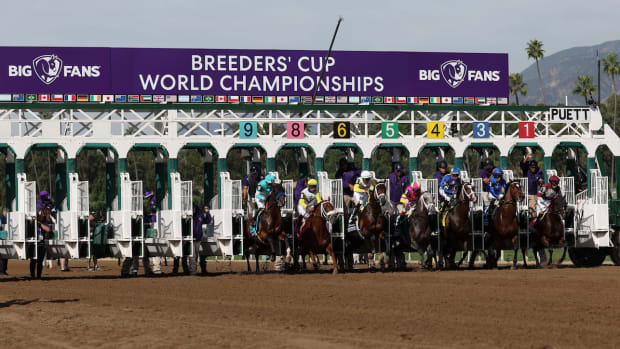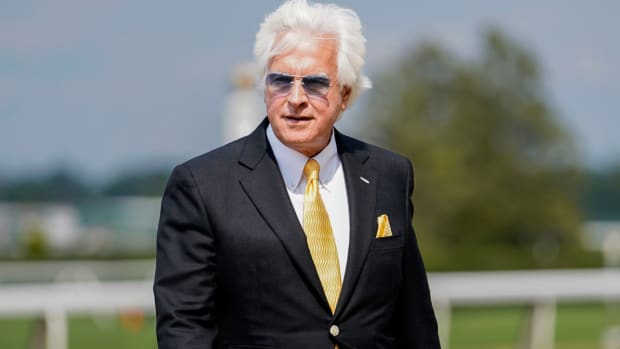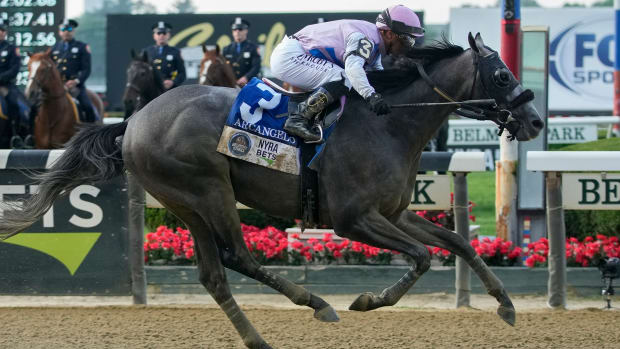American Pharoah's entourage faces very public journey to Belmont Stakes
Ten days after the Preakness and 11 before yet another Triple Crown attempt in the Belmont Stakes, thoroughbred horse trainer Bob Baffert leaned over a railing four stories above the finish line at Churchill Downs, the place where on May 2, all of this started in earnest. He looked through binoculars across the track as American Pharoah, the horse he trains and who now is the longest 1½ miles in sports away from making equine history, walked through a gap in backstretch rail and prepared to breeze half a mile in his first serious workout for the Belmont.
American Pharoah did what he does, skipping both lightly and powerfully—the paradoxical qualities that make him so good—over the Churchill surface with his ears up and pitched forward like furry antennae. He was the only horse on the track, under a morning sky that was quickly turning from cloudy to cloudless. Baffert took off his trademark sunglasses, held a walkie-talkie up to his mouth and communicated with Martin Garcia, the world-class jockey who rides American Pharoah in the morning before ceding the saddle to Victor Espinoza in the afternoon. “Wow … Oooooh,” said Baffert, not so much advising Garcia as sharing in the experience with him. “That’s beautiful, man. Beautiful.”
One more time: American Pharoah wins Preakness, nears Triple Crown
When it was finished, Baffert pushed back from the iron railing and went silent for a few seconds, which is not his nature. His flight—and Garcia’s—back home to California was leaving in 90 minutes. Baffert was scheduled to return to Churchill five days later (on Sunday night) to supervise another breeze on Monday morning and then fly to New York to answer questions, hype the Belmont and essentially act as the face of an entire sport for the better part of a week—which he has done on three other occasions since 1997. So he knows what he’s getting into. “By the time we get there,” says Baffert of New York, “we’re all going to just want to run the race.” He looked over Churchill’s historic twin spires and beyond. “But it’s nice up here right now, isn’t it?”
This is thing about horse racing, and if it sounds simplistic or obvious, well, I’m sorry about that, but it must be emphasized: Horses can't talk.
Thoroughbreds are remarkable athletes, capable of running a series of nonstop quarter miles only a little more slowly than Usain Bolt can run half that distance once. (Humans vs. horses, not fair, but a helpful illustration). They are best known in the U.S.—though not nearly as well-known as they once were—for competing in a series of races in the spring of their 3-year-old year (all horses’s birthdays are on Jan. 1), beginning with Kentucky Derby, followed two weeks later by the Preakness Stakes and three weeks after that, the Belmont Stakes. (The intervals between the races, and even the order of the races, has changed over time, but has been consistent for several decades). Together these three races are called the Triple Crown, though they aren’t connected in any way except by that name. Eleven times a horse has won all three, but none since Affirmed in 1978, the last of three Triple Crown winners in the 1970s (Secretariat in ’73 and Seattle Slew in ’77).
That drought, and a collective desperation to break it, has become racing’s overwhelming story line. (This is unfortunate and misplaced, as I wrote before the May 16 Preakness, in this column. But it’s real and it’s not going away until some horse wins the thing.) Hence, in the five weeks that separate the Derby from the Belmont, attention narrows from the 20 Derby starters and their human connections, to just a single horse and his connections. The attention becomes even more intense between the Preakness and Belmont, as interloping media jump on the Triple Crown bandwagon. American Pharoah is the 14th horse since 1978 to win the Derby and the Preakness, and the 10th in the last 18 years; it happens every time.
And because horses do not speak, and because most human journalists are limited in our ability to describe the talents of horses, we talk to the people. We write about them and broadcast about them endlessly, until there is no more blood left in the stone. (Just last week, the participants in past Triple Crowns were trotted out once again for what is becoming an annual teleconference. Steve Cauthen. Penny Chenery. Billy Turner. All very nice, willing people, saying pretty much the same things they say every time.) Baffert went through this grind with Silver Charm in 1997, with Real Quiet in ’98 and with War Emblem in 2002. Three times he has been interviewed within an inch of his life, and three times his horses have fallen short on Belmont Saturday.
The human story lines are often inescapable and endearing. Often they make the broader tale much bigger. But charm has a shelf life, and in my experience that shelf life is something short of five weeks. Owners and trainers arrive in New York frayed at the edges, tired of their own story, weary of the spotlight, physically exhausted by the pounds of flesh extracted from them every day in keeping the narrative alive until after the Belmont when, inevitably, their tales are turned 180 degrees into sad stories of yet another failed attempt at history.
American Pharoah wins Preakness, faces tough Belmont for Triple Crown
Jones and his wheelchair-bound septuagenarian owner fell into America’s embrace, but by race day, poor Roy Chapman (who died in 2006) was perched on a crowded, wheelchair-accessible seating area, craning his neck to see the long Belmont homestretch, a very tired man watching his once-in-a-lifetime horse get run down in the final furlong.
In 2008, Big Brown was dominant and fun to watch while cruising to victories in the Derby and the Preakness, but then media began peeling back the layers on his renegade trainer, Rick Dutrow (who in ’11 was banned from the sport for 10 years) and upstart owners, IEAH Stables (who are no longer running horses), and the sport held its nose as Big Brown failed to finish the Belmont. Four years after that, I’ll Have Another’s trainer, Doug O’Neill, endured five weeks of scrutiny into his long rap sheet of equine violations and then couldn’t get his horse to the starting gate. Last year, the story of California Chrome’s workaday owners was warm and fuzzy until minority owner Steve Coburn unleashed a post-Belmont tirade against horses who fail to run all three legs of the Triple Crown, which is not a requirement and never has been. (In fairness, Coburn’s argument gained some traction, but the presentation was unseemly at best.)
Baffert will arrive in New York on Tuesday and he is manifestly different from the swashbuckling 40-something former quarter horse trainer who, after losing the 1997 and ’98 Triple Crowns by less than a length, said in 2002, “Fate owes me a Triple Crown.” Now he knows better. Since his first two attempts in the late ’90s, Baffert has been divorced and remarried, lost both his parents, lived though a heart attack thousands of miles from home and endured withering scrutiny when several of his horses died of their own heart attacks. All of these things bring in perspective. Baffert wanted to win one more Derby. In a text message after the Preakness, Baffert wrote to me, “Fun from here.” I texted back, “Is it?” He replied, “Yeah. Won Derby.” As to the Belmont, Baffert said from his balcony perch at Churchill Downs last week, “Whatever happens, happens.”
Jockey Victor Espinoza, 42, went through this a year ago with California Chrome (and 12 years before that with War Emblem). He will be the first jockey to ride three times with a shot at the Triple Crown, and he has learned to handle the prerace inquisition with the aplomb of any professional athlete. And he’s good when he gets beat, too.
Owner Ahmed Zayat is a more complex character. Born in Egypt and educated in the U.S., Zayat became wealthy by selling his Egyptian beer company to Heineken for a reported $287 million. He has become one of the most successful owners in American thoroughbred racing, but also has found himself in a variety of legal entanglements that are related either loosely or closely to his racing stable.
In 2009, Zayat was sued by Fifth Third Bank, which asserted that Zayat’s racing operation had defaulted on $34 million in loans; Zayat placed the stable in bankruptcy protection early the next year. In Zayat’s bankruptcy filing, he claimed to have been owed $605,000 by New Jersey brothers Michael and Jeffrey Zelinsky, who were later sentenced to jail time for running an illegal gambling operation. Shortly after the Preakness, multiple media outlets made public a (still pending) lawsuit filed last year by convicted felon Howard Rubinsky, who alleges that Zayat failed to pay $2 million in gambling debts.
Zayat, an ebullient, combative man, has emotional explanations for all of these circumstances, which fans can either choose to embrace or dismiss. The 2010 bankruptcy filing was a “defense against predatory lending practices and broken promises made by a bank.” The Jelinskys were like “somebody you knew in high school who became criminals long after you knew them.” Rubinsky’s lawsuit is “a pathetic attempt to extort me.” (Zayat has asked for the case to be dismissed).
American Pharoah's owner named in $1.65 million gambling debt lawsuit
In the blue grass of central Kentucky, where Zayat has been a major player in the buying and breeding of horses, he is known for consistently late payment of his bills. Tom Van Meter, a veterinarian and bloodstock sales representative, owns both Van Meter Sales and Stockplace, the Lexington Farm where American Pharoah was born. “I don’t think it’s any secret around town that he’s slow to pay,” says Van Meter. “He’s tough about that, and it’s just the way he does business.” Van Meter says that he grew tired of Zayat’s tardiness two years ago and no longer boards any of Zayat’sbroodmares, but he also says, “I still get along fine with Mr. Z. We talk and we text. He is a quirky guy.”
American Pharoah also spent time at Taylor Made Farms in nearby Nicholasville, Ky. “Mr. Zayat is what we call a slow payer,” says Jacob West, buyer account manager at Taylor Made. Taylor Made also no longer boards any of Zayat’s mares and does not stand any of his stallions.
Several breeding farm professionals with whom I spoke last week in Kentucky expressed frustration that Zayat would let his payments lag while betting prodigiously. “I was with him at the Derby one year,” said one breeding farm manager, “and he’s putting money through the windows and his kids are putting money through the windows and he’s five months in arrears in his payments. I’m like, Come on man.”
Baffert, who has vigorously defended Zayat for his support of the sport, says, “I don’t think it’s any secret that he likes to gamble.”
Moreover, industry insiders are unanimous in their appreciation of Zayat’s willingness to breed and buy racehorses, despite his late payment habits. (For perspective, at the Derby, Zayat told me that it costs him $1 million per month to run his racing operation. I have no idea if that figure is accurate, but that is the figure he gave me. It’s a big number, and presumably does not include yearling or 2-year-old purchases, which can run into the millions for a single horse.)
In a text message response to a question seeking comment on this reputation, Zayat wrote, “No idea what time people are referring to. If it was during the economic crisis, then everything was slow. It’s a cash flow business. All I can tell you is we are current and a have respectable relationship with all our vendors. I have invested [tens] of millions in this industry. And I hoped I helped provide a livelihood to a lot of good people.”
Stop here for a moment. It’s fair to ask what Zayat’s financial practices have to do with American Pharoah trying to win the Belmont. Eleven years ago I wrote that Roy and Pat Chapman, the owners of Smarty Jones, first met at a meeting of Alcoholics Anonymous. That didn’t have anything to do with Smarty Jones trying to win the Belmont. I wrote that Funny Cide’s owners first got into racing at a Memorial Day cookout in their hometown of Sackett’s Harbor, N.Y. We all wrote that Rick Dutrow was loose with medication, his own and his horses’. I rode in a car through the Central Valley of California with Steve Coburn last year and listened to the wildly unlikely tale of a cheap mare and a failing stallion that produced a Kentucky Derby winner. Those stories also had nothing to do with the Belmont Stakes, but they were part of larger stories. They just were.
As to Zayat. He is a horse owner. Through the history of the game, successful horse owners have been robber barons, rapacious financiers and con men. It would be sweet if every owner was a housewife like Penny Chenery, but that’s not the case. Zayat’s bankruptcy case is long over. A court will decide if he stiffed Howard Rubinsky. In all likelihood, Zayat will continue to spend money in his own way on a game that needs his dollars. Fans will choose whether to be comfortable with that or not.
And late Saturday afternoon, if American Pharoah ends the 37-year Triple Crown drought, it will be all about the horse. Finally and blessedly.





